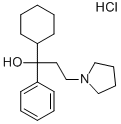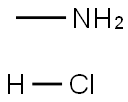PROCYCLIDINE HYDROCHLORIDE
Synonym(s):α-Cyclohexyl-α-phenyl-1-pyrrolidinepropanol
- CAS NO.:1508-76-5
- Empirical Formula: C19H30ClNO
- Molecular Weight: 323.9
- MDL number: MFCD00079236
- EINECS: 216-141-8
- SAFETY DATA SHEET (SDS)
- Update Date: 2023-06-08 09:03:02

What is PROCYCLIDINE HYDROCHLORIDE?
The Uses of PROCYCLIDINE HYDROCHLORIDE
An anticholinergic drug used in the treatment parkinson’s disease. It is also used to treat patients suffering from drug-induced parkinsonism, akathisia and acute dystonia.
brand name
Kemadrin (Monarch).
General Description
Procyclidine hydrochloride,α-cyclohexyl-α-phenyl-1-pyrrolidinepropanolhydrochloride (Kemadrin), was introduced in 1956. Althoughit is an effective peripheral anticholinergic and, indeed, hasbeen used for peripheral effects similar to its methochloride(i.e., tricyclamol chloride), its clinical usefulness lies inits ability to relieve voluntary muscle spasticity by its centralaction. Therefore, it has been used with success in thetreatment of Parkinson syndrome. It is said to be as effectiveas trihexyphenidyl and is used to reduce muscle rigidityin postencephalitic, arteriosclerotic, and idiopathic types ofthe disease. Its effect on tremor is not predictable and probablyshould be supplemented by combination with othersimilar drugs.
The toxicity of the drug is low, but when the dosageof the drug is high, side effects are noticeable. At therapeuticdosage levels, dry mouth is the most common sideeffect. The same care should be exercised with this drugas with all other anticholinergics when it is administeredto patients with glaucoma, tachycardia, or prostatichypertrophy.
Biochem/physiol Actions
Procyclidine is a synthetic anti-cholinergic agent and atropine-like antispasmodic. It exhibits therapeutic effects against Parkinson′s disease and schizophrenia. Procyclidine acts as a muscarinic receptor antagonist. It also affects N-methyl-D-aspartate (NMDA) glutamine and nicotinic acetylcholine receptors to a lower extent.
Clinical Use
Control of extrapyramidal symptoms
Acute dystonias
Metabolism
When given orally about one fifth of the dose is known to be metabolised in the liver, principally by cytochrome P450 and then conjugated with glucuronic acid. Metabolites have been found in the urine.
Properties of PROCYCLIDINE HYDROCHLORIDE
| Melting point: | 159-164 °C |
| storage temp. | 2-8°C |
| solubility | Chloroform (Slightly), Methanol (Slightly), Water (Slightly) |
| form | Solid |
| color | White to Off-White |
Safety information for PROCYCLIDINE HYDROCHLORIDE
| Signal word | Warning |
| Pictogram(s) |
 Exclamation Mark Irritant GHS07 |
| GHS Hazard Statements |
H315:Skin corrosion/irritation H319:Serious eye damage/eye irritation |
| Precautionary Statement Codes |
P280:Wear protective gloves/protective clothing/eye protection/face protection. P302+P352:IF ON SKIN: wash with plenty of soap and water. P305+P351+P338:IF IN EYES: Rinse cautiously with water for several minutes. Remove contact lenses, if present and easy to do. Continuerinsing. P332+P313:IF SKIN irritation occurs: Get medical advice/attention. P337+P313:IF eye irritation persists: Get medical advice/attention. P403:Store in a well-ventilated place. |
Computed Descriptors for PROCYCLIDINE HYDROCHLORIDE
New Products
4-Fluorophenylacetic acid 4-Methylphenylacetic acid N-Boc-D-alaninol N-BOC-D/L-ALANINOL Tert-butyl bis(2-chloroethyl)carbamate 3-Morpholino-1-(4-nitrophenyl)-5,6-dihydropyridin- 2(1H)-one Furan-2,5-Dicarboxylic Acid Tropic acid S-2-CHLORO PROPIONIC ACID ETHYL ISOCYANOACETATE 2-Bromo-1,3-Bis(Dimethylamino)Trimethinium Hexafluorophosphate (6-METHYL-[1,3]DITHIOLO[4,5-b]QUINOXALIN-2-ONE INDAZOLE-3-CARBOXYLIC ACID 4-IODO BENZOIC ACID (2-Hydroxyphenyl)acetonitrile 4-Bromopyrazole 5,6-Dimethoxyindanone 2-(Cyanocyclohexyl)acetic acid 4-methoxy-3,5-dinitropyridine 2-aminopropyl benzoate hydrochloride 1-(4-(aminomethyl)benzyl)urea hydrochloride diethyl 2-(2-((tertbutoxycarbonyl)amino) ethyl)malonate tert-butyl 4- (ureidomethyl)benzylcarbamate Ethyl-2-chloro((4-methoxyphenyl)hydrazono)acetateRelated products of tetrahydrofuran








You may like
-
 Procyclidine hydrochloride CAS 1508-76-5View Details
Procyclidine hydrochloride CAS 1508-76-5View Details
1508-76-5 -
 Procyclidine hydrochloride CAS 1508-76-5View Details
Procyclidine hydrochloride CAS 1508-76-5View Details
1508-76-5 -
 1975-50-4 98%View Details
1975-50-4 98%View Details
1975-50-4 -
 2-HYDROXY BENZYL ALCOHOL 98%View Details
2-HYDROXY BENZYL ALCOHOL 98%View Details
90-01-7 -
 2-Chloro-1,3-Bis(Dimethylamino)Trimethinium Hexafluorophosphate 221615-75-4 98%View Details
2-Chloro-1,3-Bis(Dimethylamino)Trimethinium Hexafluorophosphate 221615-75-4 98%View Details
221615-75-4 -
 61397-56-6 CIS BROMO BENZOATE 98%View Details
61397-56-6 CIS BROMO BENZOATE 98%View Details
61397-56-6 -
 14714-50-2 (2-Hydroxyphenyl)acetonitrile 98+View Details
14714-50-2 (2-Hydroxyphenyl)acetonitrile 98+View Details
14714-50-2 -
 118753-70-1 98+View Details
118753-70-1 98+View Details
118753-70-1